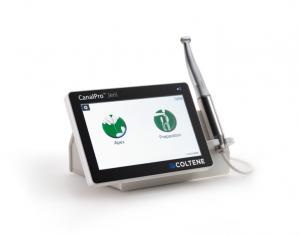Fractured instruments – new solutions to reduce the risk
Featured Products Promotional FeaturesPosted by: Dental Design 13th October 2021

During root canal treatment, the scenario of a fractured instrument has been described as a dentist’s worst nightmare. Although all steps will be taken to prevent file fracture, it is an accepted complication of this highly-complex procedure so, when getting their consent, every patient should be informed that it remains a possibility.
A clinician’s next steps – either to bypass, leave or remove the file – will depend on various factors, including the views of the patient about what they might perceive has been treatment “failure”. If they were anxious about root canal therapy before, they could react strongly when instrument fracture is disclosed. They might decide to opt for an extraction instead, rather than prolong their stress just to spend more time and money on a compromised tooth. If they believe there has been any clinical negligence, they may raise a complaint; the threat of a complaint or litigation was the most common source of professional stress among dentists according to a 2019 survey, with 79% of respondents giving it as their number-one.[i]
An unsatisfactory outcome for everyone
Even if they accepted the risk of a fractured instrument, and that you did all you could to prevent it, the patient’s overall dental experience will be negatively affected to some degree – this situation is ultimately unsatisfactory for everyone involved. You may recommend leaving the fragment where it is, because it would be too difficult to remove due to its location and/or size. Some of the literature around this area supports the idea that a retained, fractured instrument does not necessarily compromise long-term prognosis unless apical periodontitis is present. In such cases, healing is “significantly reduced” and removal is the favoured option, often using specially-designed ultrasonics.[ii],[iii]
One complication with retrieving a fractured instrument is that it might lead to the excessive destruction of healthy dentine, which is at odds with the conservative, minimally invasive approach promoted by many dentists and favoured by patients.[iv] The clinician would have to explain to the patient that, in their case, it would actually be more desirable to leave the fragment in situ, then obturate the canal and continue with the restoration. But should the patient experience any future pain with the restored tooth, or around the area where their treatment occurred, even years’ later, they might end up attributing the source of the problem to the retained instrument. Good record-keeping is key here, and it cannot be understated how communication is essential for endodontic success, generally. When a file separation is detected, via radiographs and/or on observing the broken file once it has been taken out, the patient must be informed so they can be an active participant in the decision-making about how to manage the problem. Failure to recognise fracture, as well as the failure to inform the patient, is what constitutes negligence, not the fractured file itself.
Materials and tools to reduce the risk
A fractured instrument might not be painful, but it can obstruct debridement and disinfection, as well as delaying treatment and affecting the dental experience.[v] So every dentist who delivers endodontics must do all they can to mitigate the risks. The knowledge of current techniques and the latest materials are key, as well as the ability to confidently assess a case and know when to refer to a specialist, because the canal anatomy is complex and very curved, for example. Endodontic files made from superior alloys have revolutionised endodontic safety – these are flexible, can be pre-bent and yet also offer exceptional strength for reassurance and predictability. The new generation of NiTi heat-treated files have been manufactured using processes which makes them not only more fracture resistant, and therefore safe, but have given them properties that means the number of files needed to complete treatment can be reduced.
Good endodontists will always select their materials carefully for successful and stable outcomes. Aside from files in superior alloys, for enhanced safety there are now tools available to upgrade your practise even further. The CanalPro™ Jeni endometer, with integrated apex locator and available from COLTENE, audibly warns the operator when the file is entering the danger zone for torsional fatigue. It is a highly-innovative digital notification system, which will result in less fractures, even if you are working with challenging anatomies and excessively curved canals.
Endodontic therapy is something that no patient relishes; it’s a complex, invasive procedure that requires high levels of skill and knowledge. There are never any 100% guarantees, but to support success, clinicians must work within the scope of their competency, know when to refer, ensure good patient communication and also practise careful material selection. Endodontic files are very small, thin instruments and, coupled with the complexity of the procedure and the unique qualities of each anatomy, it’s about reducing risk while only using the highest-quality tools and materials and embracing innovations to support safety even further.
Mark Allen
General Manager at COLTENE
For more on COLTENE, visit www.coltene.com,
email info.uk@coltene.com or call 0800 254 5115.
[i] Collin V, Toon M, O’ Selmo E, Reynolds L, Whitehead P. A survey of stress, burnout and well-being in UK dentists. Br Dent J. 2019 Jan 11; 226 (1): 40-49. doi: 10.1038/sj.bdj.2019.6. PMID: 30631165.
[ii] McGuigan, M., Louca, C. & Duncan, H. The impact of fractured endodontic instruments on treatment outcome. Br Dent J 214, 285–289 (2013). https://doi.org/10.1038/sj.bdj.2013.271
[iii] Madarati AA, Watts DC, Qualtrough AJ. Opinions and attitudes of endodontists and general dental practitioners in the UK towards the intra-canal fracture of endodontic instruments. Part 2. Int Endod J. 2008 Dec; 41(12):1079-87. doi: 10.1111/j.1365-2591.2008.01473.x. PMID: 19133097.
[iv] McGuigan MB, Louca C, Duncan HF. Clinical decision-making after endodontic instrument fracture. Br Dent J. 2013 Apr; 214(8):395-400. doi: 10.1038/sj.bdj.2013.379. PMID: 23619858.
[v] Br Dent J 214, 285–289 (2013).









